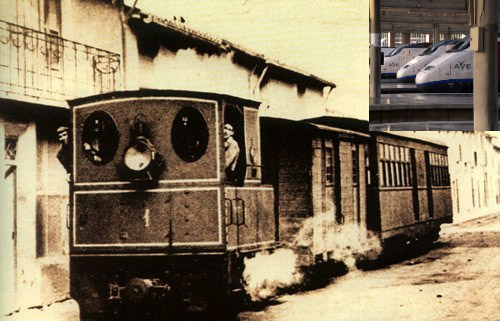By: Juan A. Bertolin
For some 20 years, regional and city based innovation and economic development policy focused on clustering, based on Michael Porter’s (1990) Competitive Advantage of Nations. However, there are still those that are doubtful about whether clusters foster economic development. In this article an alternative is proposed: the convoy model. The evidence that clusters lead to successful inter-firm regional interaction is inconclusive. Is it time for a rethink?
In the current economic situation, and bearing in mind the importance of creating new models to foster the competitiveness of our SME, it is necessary to redefine the model that has been widely implemented, i.e. the Cluster Model. We need a new model that will become the metaphor for accelerated and new economic, technological and societal growth in the decade to 2020.
By chance, I met Prof. G. Mensch,[3] a rather interesting person with a unique idea, which we have been developing in partnership. Prof. Mensch had the idea of ’The Convoy Model’.
Tractor as the keystone agent of the Convoy Model
The Convoy Model relies on a key element ‘tractor’. The tractor is the driving unit, similar to a consolidated company which, once established, attracts the co-location of related satellite companies. These satellite companies may belong to other sectors and disciplines and be engaged in activities related to the company’s main mission. Co-location of these companies encourages cooperative working (competing + cooperating) towards a common target.
The Convoy Model does not relate to a specific sector. It can be likened to an articulated vehicle whose total weight is driven by the traction element also called the “locomotive” of the convoy of cars, if you will, and it is crucial to identify how many “locomotives” of the convoy do we have.

Convoy as Model
The Convoy Model is dynamic compared to Porter’s static cluster model; it is planned rather than evolving. It acts as a magnet attracting collaboration / initiatives that enable continuous improvements, continuous value creation, and synergies. The Convoy Model drives the elements in the innovation ecosystem via a main company or project – the tractor.
The Convoy Model can be considered as providing the motion in a cluster: all the positive economic impacts highlighted by Porter (new jobs, economic wealth, etc.) apply also to this new model. In other words, we would agree that the co-location of companies, customers, suppliers and others institutions increases the perception of innovation opportunities while amplifying the pressure of innovation (Porter, 2000). However, these effects are amplified in the Convoy Model, since the group’s entrepreneurial activity is focused on the needs of the ‘tractor’ company or project.
The Convoy Model can be used to regenerate traditional sectors and traditional management techniques, that have been unable to adapt to the future.
For instance, the Castellon tiles and ceramics cluster in Spain has been greatly affected by the global financial crisis, which has led to many companies closing or being restructured. The atomized structure of the cluster meant that the main focus was on production, with marketing, distribution and processes of less interest. However, this focus needs to change to create new business opportunities to compete against low cost resources and production in Asia.
Tractor Agents and the Project Management landscape
How do new tractors emerge? We need a “thinkubator” structure to create an environment appropriate for the generation of new ideas, which, once identified, can be implemented in the very short term. This will involve tools such as Living Lab, a co-creation technique based on crowdsourcing. Living Lab is a good example of a Convoy Model where decisions are made about specific goals and their achievement is supported by numerous agents in a ‘fish-bone’ structure.

The project management methodology is crucial in the context of this complex new model and requires a new perspective. Projects are not implemented just to respond to user requirements; they must be capable of ongoing adaptation to changing requirements and new products. The final goal may be different from the initial target based on initial user requirements. This requires flexibility, and new project management paradigm and a HIST (High Impact, Short Time) philosophy meaning that projects perform based on continual feedback.
Cluster model perspective
Convoy is a more powerful metaphor than cluster to describe a local economic development strategy and is worthy of equal attention.
The notion of cluster to refer to business and economic environments has been around since the beginning of the 1990s, since Porter’s (1990) The Competitive Advantage of Nations, but the underlying concept of agglomeration economies was familiar to economists as long ago as the 1890s evident in the work of Alfred Marshall.
The cluster, defined as a ‘geographic concentration of business initiatives, suppliers and associated institutions in a particular field’ has played an important role in enhancing firms’ productivity. Clusters have enabled member firms to achieve important competitive edge in national and international markets.
Porter adopted the cluster model to promote innovation and stimulate new sectoral business initiatives. Geographic clusters have developed in diverse areas of expertise: biotechnology, ICT, health, environment, etc..
An example of one of the most important clusters is Silicon Valley in California, established in the 1990s based on a group of technology companies which attracted venture capital investment and other companies. The partnerships forged (cross pollination) have generated new business initiatives.
Another example is the tile cluster in the province of Castellon in Spain (referred to by Porter as an example of a cluster able to compete with Saussuolo in Italy and Santa Caterina in Brazil), which is analysed by the Jordan Competitiveness Team.
Clusters have certain characteristics:
- They are static elements, capable of growing by approximation. That is, entrepreneurs are released tin Clusters, in their particular sector, in order to “absorb the aroma of innovation environment”. In many cases, firms join clusters in the hope that this will generate new business, in most of cases by serendipity.
- Clusters are focused on specific products or services and knowledge areas aligned to their location’s economic and industrial needs . As Ketels [2] states: ‘The necessary condition for any kind of empirical work on Clusters is to find a consistent definition of what economic activities belong or should belong to the cluster.’
- The movement that businesses follow when they land in a Cluster belonging to their sector is rather “Brownian”, ie without prior planning and spinning around looking for business opportunities.
Ketels also suggests that a cluster location increases the efficiency and effectiveness of cluster firms. Cluster location may mean that financial investment generates greater economic value than their opportunity costs.
Another aspect to bear in mind is the sustainability of a cluster once the initial phase has finished (when more support is needed) and indeed, cluster is a long term process so the final cost could be higher than expected).
Conclusions
We need to re-think the reinforcement of wealth creation in regions and innovative solutions that promote radical and positive change similar to what happened in 1945 when a group of orange growers decided to set up a tile company in Castellon following a particularly hard winter when the orange blossom was severely frosted, and the orange harvest, the mainstay of the economy at the time, failed.
By Juan. A. Bertolin
About the author
 Juan A. Bertolin is currently the Chief Innovation Officer (CIO) at espaitec, Science and Technology Park of the University Jaume I of Castellon (Spain). Juan Antonio, graduated in Physics by the University of Valencia and post doc in General Direction by Universitat Oberta of Catalonia, has spent most of his professional life, more than 15 years, as Project Manager in international consulting firms such as Accenture or national ones such as IT Deusto. He joined to the espaitec team in 2006 with the aim of launching the new Science and Technology Park (STP) which main role is fostering the hybridation among the companies based on the STP (start-ups, spin-off, grow-up, tractors) and its connection to the Global Innovation System providing strategies of technology surveillance and innovative project management protocols (high impact-low cost).
Juan A. Bertolin is currently the Chief Innovation Officer (CIO) at espaitec, Science and Technology Park of the University Jaume I of Castellon (Spain). Juan Antonio, graduated in Physics by the University of Valencia and post doc in General Direction by Universitat Oberta of Catalonia, has spent most of his professional life, more than 15 years, as Project Manager in international consulting firms such as Accenture or national ones such as IT Deusto. He joined to the espaitec team in 2006 with the aim of launching the new Science and Technology Park (STP) which main role is fostering the hybridation among the companies based on the STP (start-ups, spin-off, grow-up, tractors) and its connection to the Global Innovation System providing strategies of technology surveillance and innovative project management protocols (high impact-low cost).
References
[1] “The Development of the cluster concept – present experiences and Further Developments”, 2003
